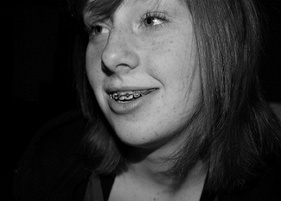









caring for your braces
Copyright © 2013
Jason M. Pambrun, DDS, MS
All Rights Reserved.
Jason M. Pambrun, DDS, MS
All Rights Reserved.
Although patients are able to eat or drink many foods while in orthodontic
treatment, there are certain eating habits that are known to cause
breakage of orthodontic appliances and braces as well as increasing the
risk of dental problems. Our aim is to allow our patients to achieve the
treatment goals with as few disturbances due to appliance breakage as
possible, and to minimize the side effects of poor food choices and poor
oral hygiene. Remember, teeth move their best in a healthy environment
and in individuals with excellent overall dental heath. Patient cooperation
is key to successful orthodontics.
What foods should I avoid?
Food and drink your dentist has suggested may cause dental decay should be restricted while wearing braces. Sticky foods are to be avoided because of the increased risk of dental decay and appliance breakage. These foods stick to your braces and remain on your teeth for long periods of time. If foods or drinks high in sugar content are to be consumed, we advise having them with regular meals or at one given time of day. Please make sure that careful brushing and rinsing take place immediately afterwards. Snacks should be confined to foods without refined sugar and should be followed by brushing or vigorous rinsing if a toothbrush is unavailable.
Wearing braces limits the foods that you are permitted to eat. Improper foods can bend and distort wires causing treatment delays and extra visits for repairs. In general hard, brittle, crunchy and sticky foods should NOT be eaten during orthodontic treatment. Hard crunchy foods can bend and break the braces and wires, while sticky foods may loosen them. Certain foods may be eaten if they are prepared in a special way. Whole fruits and vegetables or any raw foods such as apples, celery and carrots should be sliced and eaten carefully. Hard crusty breads should be broken and eaten in small pieces. Corn may be eaten if sliced off the cob.
Do not suck on lemons or limes (citric acid in juice can dissolve tooth enamel) and especially do not suck or chew ice cubes. Chewing ice cubes can be very destructive to your appliances and teeth. Keep fingernails, pencils and other objects out of your mouth. Do not put anything in your mouth that may tend to end, break, pry, pull or knock off the braces. Popcorn can cause harm in multiple ways. The husks from the popcorn can become lodged beneath the braces and cause irritation of the gum tissue. Unpopped kernels can shear or break off brackets as well as bend or dislodge wires.
The following is a list of only some of the foods you should avoid as you should use your own good judgment while eating anything. No matter what you eat, please clean the teeth and gum tissue thoroughly after eating any food and especially before bedtime.
Here are some tips on the types of foods to avoid:
Hard Foods:
Popcorn
Nuts, peanut brittle Ice
Hard candy
Hard chips
Candied apples
Corn-on-the-cob
Sticky Foods:
Fruit Roll-ups
Gummy bears
Taffy and Caramels
Starburst
Bit-O-Honeys
Skittles
Milk Duds etc.
Be careful with these foods:
Carrots - grate or cut into tiny pieces
Apples - cut into wedges - don't bite
Hard French bread - tear into small pieces
Limit foods with a high sugar content:
The acids produced by high sugar content foods can attack for twenty minutes or more each time you eat. So, the best time to eat carbohydrates or other sugary foods is during a meal. The mouth produces more saliva during a meal which, in turn, helps to neutralize acid production and rinse food from the mouth. If possible, brush immediately after eating. If it is not possible to do so, rinsing with clear water will help.
Other Orthodontic "No-Nos":
Lip biting
Pushing your tongue against your teeth
Chewing on pencils or pens
Tearing things with your teeth
Biting your fingernails
Dental Hygiene during Treatment
As you eat, your teeth, braces and appliances collect food. If food is left on teeth overnight, a thick plaque forms on the teeth and gums. Plaque causes bad-breath, tooth decay and gum disease (swollen, puffy, red, overgrown, or bleeding gums). Drinks and foods containing sugar can damage the tooth surfaces and gum tissue. Bleeding and swollen gums are a sure sign that plaque is not being properly removed. If your gums are swollen and inflamed your teeth will not move as easily, you will experience more discomfort during your treatment and white spots or decay will form on the teeth under and around the braces and appliances. It is discouraging to work hard to straighten teeth, only to finish and find decay or white spots on the teeth.
The following is essential for the proper care of your teeth and gums:
Waterpik-
We highly recommend the use of a Waterpik to loosen food and plaque before flossing and brushing. The Waterpik should be used on the lower water pressure settings so the gum tissue is not excessively irritated. The use of a Waterpik does not take the place of good toothbrushing.
Dental Floss-
Although somewhat time-consuming, dental floss should be used when wearing braces or appliances. Floss at least once per day just before bedtime and use a floss threader if necessary.
Soft Bristled Toothbrush-
Use your toothbrush after each meal and before bedtime. A travel brush carried in a purse or placed in a locker is great for brushing after lunch. Examine your teeth for food and plaque and thoroughly clean all surfaces of the gums, teeth and braces. Re-examine your teeth to make sure all visible food and plaque have been removed. Repeat this step as often as needed to assure that no visible plaque or food remains. Extra care must be taken in the area between your gums and the braces. Concentrate on brushing your gums and the gumline as well as your teeth.
Electric Toothbrush-
Although it is not absolutely necessary for good hygiene, an electric toothbrush may make brushing easier.
MI Paste®-
Every new patient is given a tube of MI Paste, a specially formulated paste to be used after night time brushing and to be left on the teeth while sleeping. Research has shown that use of this paste strengthens the enamel and can actually reduce the incidence and appearance of white spots. Each tube should last a couple of months. If you need more, it is available on line or from our office.
A Few Tricks-
Since most patients watch some TV, we have found it to be effective to sit down in front of the TV daily with a toothbrush without toothpaste, and massage the teeth and gums with the toothbrush bristles for about 30 minutes. Thirty minutes gives you plenty of time to do a good job, and makes TV time more productive. Brushing while listening to music or studying is also acceptable. You may want to use toothpaste to freshen your breath, but don't use toothpaste during this 30 minutes. We want you to avoid the "once over lightly" technique. To concentrate better, you may use your left hand if you are right handed, and vice versa. The most important time to brush is just before going to bed. Take your time and do it right.
Regular Dental Checkups-
Although you are having your braces checked regularly, it is very important to continue to see your family dentist at least every six months for a thorough examination and cleaning of your teeth. If you experience difficulty with good oral hygiene you my need to see your dentist more frequently.
What foods should I avoid?
Food and drink your dentist has suggested may cause dental decay should be restricted while wearing braces. Sticky foods are to be avoided because of the increased risk of dental decay and appliance breakage. These foods stick to your braces and remain on your teeth for long periods of time. If foods or drinks high in sugar content are to be consumed, we advise having them with regular meals or at one given time of day. Please make sure that careful brushing and rinsing take place immediately afterwards. Snacks should be confined to foods without refined sugar and should be followed by brushing or vigorous rinsing if a toothbrush is unavailable.
Wearing braces limits the foods that you are permitted to eat. Improper foods can bend and distort wires causing treatment delays and extra visits for repairs. In general hard, brittle, crunchy and sticky foods should NOT be eaten during orthodontic treatment. Hard crunchy foods can bend and break the braces and wires, while sticky foods may loosen them. Certain foods may be eaten if they are prepared in a special way. Whole fruits and vegetables or any raw foods such as apples, celery and carrots should be sliced and eaten carefully. Hard crusty breads should be broken and eaten in small pieces. Corn may be eaten if sliced off the cob.
Do not suck on lemons or limes (citric acid in juice can dissolve tooth enamel) and especially do not suck or chew ice cubes. Chewing ice cubes can be very destructive to your appliances and teeth. Keep fingernails, pencils and other objects out of your mouth. Do not put anything in your mouth that may tend to end, break, pry, pull or knock off the braces. Popcorn can cause harm in multiple ways. The husks from the popcorn can become lodged beneath the braces and cause irritation of the gum tissue. Unpopped kernels can shear or break off brackets as well as bend or dislodge wires.
The following is a list of only some of the foods you should avoid as you should use your own good judgment while eating anything. No matter what you eat, please clean the teeth and gum tissue thoroughly after eating any food and especially before bedtime.
Here are some tips on the types of foods to avoid:
Hard Foods:
Popcorn
Nuts, peanut brittle Ice
Hard candy
Hard chips
Candied apples
Corn-on-the-cob
Sticky Foods:
Fruit Roll-ups
Gummy bears
Taffy and Caramels
Starburst
Bit-O-Honeys
Skittles
Milk Duds etc.
Be careful with these foods:
Carrots - grate or cut into tiny pieces
Apples - cut into wedges - don't bite
Hard French bread - tear into small pieces
Limit foods with a high sugar content:
The acids produced by high sugar content foods can attack for twenty minutes or more each time you eat. So, the best time to eat carbohydrates or other sugary foods is during a meal. The mouth produces more saliva during a meal which, in turn, helps to neutralize acid production and rinse food from the mouth. If possible, brush immediately after eating. If it is not possible to do so, rinsing with clear water will help.
Other Orthodontic "No-Nos":
Lip biting
Pushing your tongue against your teeth
Chewing on pencils or pens
Tearing things with your teeth
Biting your fingernails
Dental Hygiene during Treatment
As you eat, your teeth, braces and appliances collect food. If food is left on teeth overnight, a thick plaque forms on the teeth and gums. Plaque causes bad-breath, tooth decay and gum disease (swollen, puffy, red, overgrown, or bleeding gums). Drinks and foods containing sugar can damage the tooth surfaces and gum tissue. Bleeding and swollen gums are a sure sign that plaque is not being properly removed. If your gums are swollen and inflamed your teeth will not move as easily, you will experience more discomfort during your treatment and white spots or decay will form on the teeth under and around the braces and appliances. It is discouraging to work hard to straighten teeth, only to finish and find decay or white spots on the teeth.
The following is essential for the proper care of your teeth and gums:
Waterpik-
We highly recommend the use of a Waterpik to loosen food and plaque before flossing and brushing. The Waterpik should be used on the lower water pressure settings so the gum tissue is not excessively irritated. The use of a Waterpik does not take the place of good toothbrushing.
Dental Floss-
Although somewhat time-consuming, dental floss should be used when wearing braces or appliances. Floss at least once per day just before bedtime and use a floss threader if necessary.
Soft Bristled Toothbrush-
Use your toothbrush after each meal and before bedtime. A travel brush carried in a purse or placed in a locker is great for brushing after lunch. Examine your teeth for food and plaque and thoroughly clean all surfaces of the gums, teeth and braces. Re-examine your teeth to make sure all visible food and plaque have been removed. Repeat this step as often as needed to assure that no visible plaque or food remains. Extra care must be taken in the area between your gums and the braces. Concentrate on brushing your gums and the gumline as well as your teeth.
Electric Toothbrush-
Although it is not absolutely necessary for good hygiene, an electric toothbrush may make brushing easier.
MI Paste®-
Every new patient is given a tube of MI Paste, a specially formulated paste to be used after night time brushing and to be left on the teeth while sleeping. Research has shown that use of this paste strengthens the enamel and can actually reduce the incidence and appearance of white spots. Each tube should last a couple of months. If you need more, it is available on line or from our office.
A Few Tricks-
Since most patients watch some TV, we have found it to be effective to sit down in front of the TV daily with a toothbrush without toothpaste, and massage the teeth and gums with the toothbrush bristles for about 30 minutes. Thirty minutes gives you plenty of time to do a good job, and makes TV time more productive. Brushing while listening to music or studying is also acceptable. You may want to use toothpaste to freshen your breath, but don't use toothpaste during this 30 minutes. We want you to avoid the "once over lightly" technique. To concentrate better, you may use your left hand if you are right handed, and vice versa. The most important time to brush is just before going to bed. Take your time and do it right.
Regular Dental Checkups-
Although you are having your braces checked regularly, it is very important to continue to see your family dentist at least every six months for a thorough examination and cleaning of your teeth. If you experience difficulty with good oral hygiene you my need to see your dentist more frequently.
5903 East Mall
Atascadero, Ca. 93422
Tel: 805-466-1064
Fax: 805-466-2908
Atascadero, Ca. 93422
Tel: 805-466-1064
Fax: 805-466-2908
Pambrun Bracing/Classic Smiles by Dr. Jason M. Pambrun is a premiere Atascadero, California orthodontic office (orthodontist / dentist),
providing braces, clear braces, gold braces, and Invisalign® (invisible braces) in Atascadero, CA
Website created by Dr. Jason M. Pambrun (Atascadero orthodontist, North County orthodontist) forPambrun Bracing/Classic Smiles by Dr. Jason M. Pambrun, providing braces, clear braces, gold braces, Invisalign (invisible braces) to Atascadero, Cambria, Cayucos, Creston, Morro Bay, North County San Luis Obispo, Paso Robles, San Luis Obispo, Santa Margarita, San Miguel, Shandon, Templeton
Website created by Dr. Jason M. Pambrun (Atascadero orthodontist, North County orthodontist) forPambrun Bracing/Classic Smiles by Dr. Jason M. Pambrun, providing braces, clear braces, gold braces, Invisalign (invisible braces) to Atascadero, Cambria, Cayucos, Creston, Morro Bay, North County San Luis Obispo, Paso Robles, San Luis Obispo, Santa Margarita, San Miguel, Shandon, Templeton













